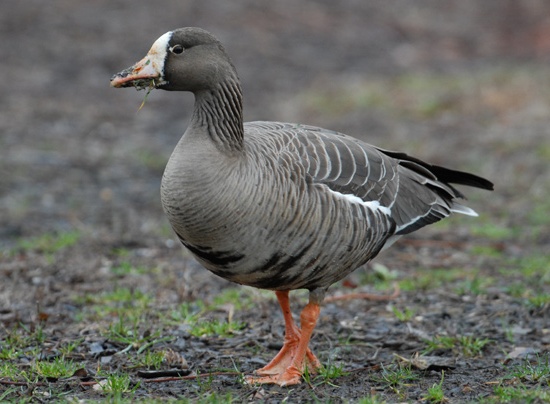
Greater white-fronted goose(Anser albifrons)
Phylum —chordata
Class — aves
Order — anseriformes
Family — anatidae
Genus – anser
Appearance
Greater white-fronted geese are 64–81 cm (25–32 in) in length, have a 130–165 cm (51–65 in) wingspan and weigh 1.93–3.31 kg (4 lb 4 oz–7 lb 5 oz). They have bright orange legs and mouse-colored upper wing-coverts.
The male is typical larger in size, both sexes are similar in appearance: greyish brown birds with light grey breasts dappled with dark brown to black blotches and bars. Both males and females also have a pinkish bill and orange legs and feet.
Habitat
Three subspecies of greater white-fronted geese occur in North America. The Pacific white-fronted goose breeds in eastern Siberia, in arcticAlaska from the Bering Sea Coast east to the Mackenzie River, and on Saint Lawrence Island. It winters in the western United States, east to Louisiana, in western and central Mexico, and in China and Japan.
The breeding grounds of the tule greater white-fronted goose are uncertain; however, it probably breeds in the Mackenzie Basin region of Canada. The tule greater white-fronted goose winters in California (the Great Central Valley), Texas, and Louisiana.
The Greenland white-fronted goose breeds on the west coast of Greenland and in the taiga of the Mackenzie Basin region of Canada; it winters mainly in Ireland but occasionally winters in eastern Canada and the eastern United States along the Atlantic Coast.
Behavior
Greater white-fronted geese are strong fliers that fly in single file or in "V" formation. They typically call in flight - a high-pitched laugh. When they are ready to come in for a landing they teeter from side to side similar to a falling leaf.
Outside of the breeding season, greater white-fronted geese are social birds and often gather in groups. On the breeding grounds they defend the nest site, threatening intruders in a bent-over posture with the neck stretched straight out. On some occasions males may physically attack each other. Greater white-fronted geese form long-term pair bonds and stay together year-round. Pairs are often accompanied by their young for the first year or more, and the young often help their parents defend the nest. Juveniles don't breed until they are around 2.5 years old, at which point they leave the family group. Greater white-fronted geese return to the same breeding area year after year and often return to the same wintering area.
Diet
Greater white-fronted geese eat primarily sedges, grasses, berries, and plant tubers during the summer and seeds, grain, and grasses in the winter. They peck at vegetation and stems, plucking tubers, seeds, or grains from plants. In the water they peck at emergent vegetation and submerge their head to reach underwater plants.
Reproduction
Greater white-fronted geese are monogamous and form lifelong pair bonds. Bond forming occurs in the fall and into the early spring. Greater white-fronted geese breed once a year in the summer, beginning in late May. Clutches may include 4 to 7 eggs per season. Incubation lasts 27 days on average. Maturity in greater white-fronted geese is reached at 3 years of age.
In captivity
When keeping this species, it is necessary to have a pool with water or a natural reservoir. The optimal ratio of the reservoir area to pasture is 20% water and 80% pasture. The optimal area of the entire enclosure is 200 sq. m. The optimal height of grass in the pasture is 7.5 cm.
It is necessary to build a poultry house on the territory of the aviary. Geese will be able to hide in it from the cold and wind in the cold season. You need constantly to update the litter in the poultry house. For such bedding, you will need about 40 kg of dry straw (hay). It is important to replace the wet bedding in time. Otherwise, the plumage quickly becomes dirty and does not protect the bird from the cold.
The poultry house should be made of wood or mud. Humidity and drafts are not allowed in it. Proper maintenance of geese is the key to their health.
During the construction of a poultry house, it is very important to take into account that at least one square meter of floor space should be allocated for one adult goose. With a higher density, the room will quickly become polluted, and the air in it will stagnate. This can cause diseases of wild geese and significantly reduce their productivity. Once a year, you need to whitewash the walls with freshly slaked lime.
Geese eat natural grasses. You can add to herbs: wheat grains, waterfowl pellets, and chicken feed. If there is not enough grass on the pasture, it is necessary to bring mown fresh grass. In winter, you can feed sliced vegetables, especially good to give cabbage and salads. Not averse to eating worms, insects and shellfish sometimes.
Greater white-fronted geese should be kept separate from other types of geese.
 Russian
Russian
 English
English
























